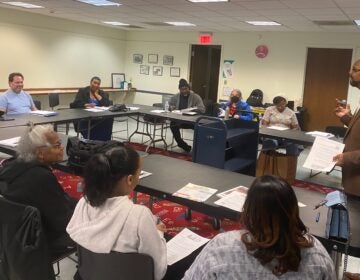LGBTQ Home for Hope riding ‘Wall of Love’ momentum toward funding goals [video]

Just days after more than 1,000 people formed a “Great Wall of Love” to counter the homophobic hate of four Westboro Baptist Church picketers during the Democratic National Convention in Philadelphia in July, the wall’s organizers – still smiling from all the love – began asking each other an intriguing question.
Can love become cash?
“How does a rally of a thousand people translate into dollars?” said Tyler Lynch, who helped organize the happy counter-protest outside the Mazzoni Center’s health clinic in Center City.
Looking to build on the Great Wall of Love’s success, Lynch and other organizers have adopted the LGBTQ Home for Hope, a homeless shelter in Fairhill specifically for gay and transgender people in recovery from drugs, trauma, sex work, mental illness, and criminal trouble.
During the next year, they’ll raise money and draft volunteers to make repairs and renovate the 38-bed shelter in the 122-year-old, four-story, gray-stone house on Hutchinson Street near Cambria.
The first priority: To cultivate enough ongoing donations to cover the home’s $9,000 monthly operating expenses. Organizers also eventually aim to install a security system, fix the broken kitchen stove, replace old windows, wiring and plumbing, buy portable space heaters, create a Target gift registry to provide for residents’ needs, and otherwise renovate the run-down home.
“It seemed to fit to use the momentum from the Great Wall of Love to continue to help the community,” said Deja Lynn Alvarez, the home’s director, who also helped organize the Great Wall of Love. “What better place to start helping the community than a place that helps the most vulnerable members of that community?”
Lynch, Lee Embrey and others spearheading the effort to help the home have set up a GoFundMe page to raise money. They also plan to hold a “dunk tank” fundraiser during OutFest on Oct. 9.
Originally a rectory for the since-demolished St. Bonaventure Roman Catholic Church, the property operated for years as Hannah’s House, a halfway house for female prisoners transitioning back to the community.
After that closed, Alvarez partnered with the Divine Light, which runs recovery centers, and its CEO Sakina Dean in September 2015 to open the Divine Light LGBTQ Wellness Center there. Alvarez changed the shelter’s name in May to the LGBTQ Home for Hope, worried that “Divine Light” carried religious connotations that could intimidate prospective residents, Alvarez said.
With all LGBT staff and its inclusiveness to downtrodden LGBT people in any kind of recovery, the home fills a void in the community, Alvarez said.
“Going to other shelters and such, you are oftentimes just turned away at the door if you’re trans,” Alvarez said. “Or if you are allowed in, you’re told, for those who have to wear wigs, you’re not allowed to wear a wig, you’re not allowed to wear makeup, you have to dress down, you can’t show body parts. If you’re gay, you’re constantly harassed, teased, oftentimes raped and abused by other residents and staff.”
Transgender people have higher rates of homelessness, because many have trouble finding work or get booted from their homes due to transphobia, according to the 2011 National Transgender Discrimination Survey.
Yet nearly a third of homeless trans people who try to get into a homeless shelter get turned away, while 42 percent can only get into shelters that don’t match their gender identity, according to the survey. More than half of those who have spent time in homeless shelters have experienced harassment by shelter staff or residents, while nearly a quarter reported that they had been sexually assault by residents or staff, the survey found.
Of the LGBTQ Home for Hope, Lynch said: “This is a safe place for people to go and get back on their feet.”
Victoria Dawson moved in a few weeks ago, after leaving prison, and later, a halfway house, where a judge sent her after she got convicted in a drug case. In those places, she said, she was housed with men and encountered both physical assaults and disrespect.
At the LGBTQ Home for Hope, she doesn’t get treated “like some mutant,” she said.
“I really love this place. A lot of people here understand me; it’s like a sanctuary,” said Dawson, 37, of Southwest Philadelphia.
Joshua Rembert, 29, a New Yorker now stuck in Pennsylvania because he’s on probation for drug and assault offenses, arrived at the LGBTQ Home for Hope about six months ago. Staffers hooked him up with health care at the Mazzoni Center, helped him get him Pennsylvania identification, and has helped him stay clean, he said.
“I’d probably still be in prison without resources like this,” he said. “Drugs made my life unmanageable; to live a clean life is a mandatory thing.”
Rembert now works at the center, manning a weekend shift.
“It really gives me a chance to give back what was freely given to me,” Rembert said. “That’s a really powerful thing.”
WHYY is your source for fact-based, in-depth journalism and information. As a nonprofit organization, we rely on financial support from readers like you. Please give today.




